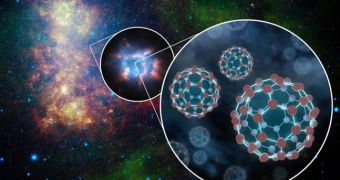A group of astronomers announces that it has managed to demonstrate the existence of nanoscale carbon structures known as buckyballs in three planetary nebulae inside the Milky Way.
This means that the cage-like molecules may indeed permeate the Universe, as proposed in several past scientific studies, which means that they might have been responsible for delivering the seeds of life to our planet.
Over the past few years, astronomers have begun proposing that life is not indigenous to Earth, and that it arrived here either on comets or asteroids. Even the oceans are now believed to be the result of massive space impacts between Earth and icy comets.
Given how much buckyballs are spread throughout the Universe, it stands to reason that they could be the containers that carry within the molecules that would later go on to organize into life's precursors.
In the new investigation, researchers were able to discover the structures, arranged in the shape of a ball, and made up of 60 linked carbons, permeating our galaxy, the space between its stars, and also the area around three dying stars, Space reports.
Using the NASA Spitzer Space Telescope, the group also confirmed the existence of the stuff around a fourth planetary nebula, that concentrated the mass of 15 Earth moons in buckyballs.
The reasons they such high amounts of the chemical structure were found around this particular object eludes scientists for now.
“It turns out that buckyballs are much more common and abundant in the Universe than initially thought. This has implications for the chemistry of life,” says expert Letizia Stanghellini.
She holds an appointment as an astronomer at the National Optical Astronomy Observatory (NOAO), in Tucson, Arizona. “It's possible that buckyballs from outer space provided seeds for life on Earth,” the scientist adds.
An interesting thing to note about this discovery is that the buckyballs were discovered inside planetary nebulae, which means that they resided in an extremely hydrogen-rich environment.
Experts did not expect to see such a thing in their research, given that lab experiments cannot produce the carbon-based structures in the presence of hydrogen gas.
Chemists until now believed that hydrogen would contaminate the carbon if put together, causing connections to form, and leading to the appearance of other chemicals.
“We now know that fullerenes and hydrogen coexist in planetary nebulae, which is really important for telling us how they form in space” explains scientist Anibal Garcia-Hernandez.
The expert, who is based at the Instituto de Astrofisica de Canarias, is the lead author of the new investigation, details of which appear in the October 28 online issue of the esteemed Astrophysical Journal Letters.
“Buckyballs are sort of like diamonds with holes in the middle. They are incredibly stable molecules that are hard to destroy, and they could carry other interesting molecules inside them,” Stanghellini says.
“We hope to learn more about the important role they likely play in the death and birth of stars and planets, and maybe even life itself,” she adds.

 14 DAY TRIAL //
14 DAY TRIAL //